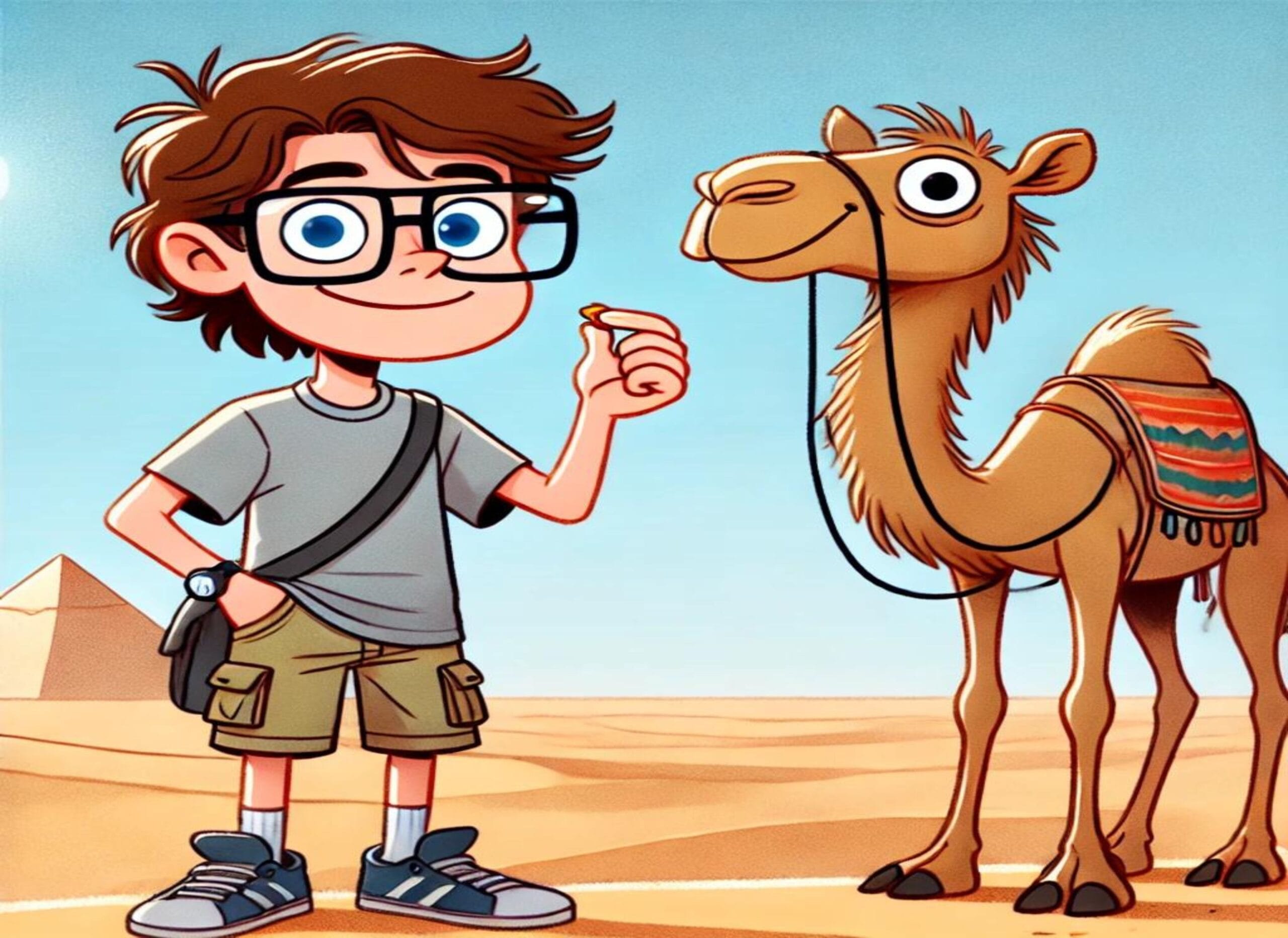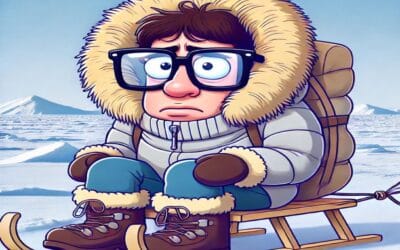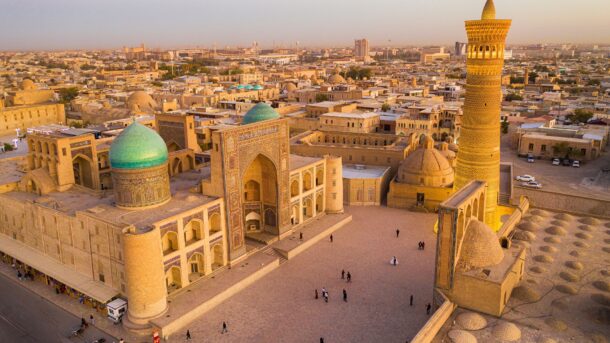Note: This is a fictional survival guide. For the non-fictional survival guide, see How to Survive in a Hot Desert.
Synopsis
Meet Brad, a 20-year-old computer programmer from Silicon Valley. Picture this: messy brown hair that looks like it’s constantly recovering from a fight with a keyboard, glasses that are perpetually slipping down his nose, and a wardrobe that consists mainly of tech conference t-shirts and cargo shorts—because, apparently, more pockets means more room for USB drives and snacks. Brad’s idea of a wild adventure usually involves debugging code or playing the latest strategy game, so when his friends convinced him to take a vacation in Egypt, he thought, Why not?
Brad had seen a documentary about the pyramids once (okay, maybe it was a video game cutscene), and he was pretty sure he could handle a little Egyptian heat. After all, he’d survived the legendary coffee drought of last year’s hackathon. But Egypt was a whole different beast. It wasn’t long before his meticulously planned, Google Maps-guided pyramid tour went off course.
One minute, Brad was happily snapping photos of camels and ancient ruins, feeling like Indiana Jones in cargo shorts. The next, he realized he’d wandered way too far from the tour group—like, miles too far. His phone’s GPS was out of service, naturally, and he was left standing in the middle of the desert, staring at nothing but sand dunes and the blazing sun. He tried to reassure himself with the same confidence he used during late-night coding sessions, but this wasn’t an algorithm he could debug.
And that’s how Brad—a guy who usually battles lag and glitches—ended up lost in the Sahara Desert, armed with nothing but a backpack full of water, some questionable snacks, and the survival knowledge he’d picked up from a documentary (okay, fine, it was YouTube).
Day 1: Contemplation
I’d always had this grand idea of what an adventure in the desert would be like—wide-open spaces, golden dunes, maybe a moment where I’d connect with my inner explorer. You know, the kind of trip where I’d imagine myself standing tall against a backdrop of rolling sand, looking like some rugged adventurer from a postcard. Well, reality had other plans. The second I stepped off the plane, the desert hit me with a heat so intense it felt like I’d walked into an oven. Not exactly the mystical experience I’d envisioned. If I’m honest, I immediately started questioning my life choices. Like, why didn’t I just go to the beach? At least there’s ice cream there.
Fast forward a few hours, and I found myself in the middle of nowhere—miles of nothing but sand, more sand, and oh yeah, did I mention sand? I was supposed to be on an adventure, but it quickly felt more like I’d stumbled into the set of a survival show. One where the only goal was not to spontaneously combust under the sun. Determined to play it cool (and totally not look like a rookie), I set off into the desert with more confidence than common sense. I’d read all about how desert explorers wrap themselves in layers to “trap sweat” and keep cool, so naturally, I followed suit. Except, instead of looking like a rugged adventurer, I looked like I’d raided my grandma’s linen closet. Wrapped up in a hodgepodge of layers, I resembled a slightly frantic, overheated mummy.
It didn’t take long for the sweat to start pouring, and I quickly realized that sweat wasn’t the badge of honor I thought it’d be. My outfit, which I had so meticulously planned, transformed into a sweaty, billowing mess, and I felt more like a human hot air balloon than a desert explorer. I had to rethink my entire approach. The trick to surviving the desert heat, as it turns out, is not about wearing more clothes—it’s about wearing the right clothes. After some quick adjustments, I found myself in a much more reasonable outfit: a loose cotton undershirt, a light windbreaker, and a hat so wide-brimmed it could’ve doubled as portable shade. Did I look like I was trying out for a role in Lawrence of Arabia? Absolutely. But at least I wasn’t actively melting.
Then there was the water situation. I had seriously overpacked, thinking it was better to be safe than sorry. My backpack weighed a ton, stuffed with enough water bottles to supply a small desert outpost for a week. As I trudged through the dunes, it felt like my backpack was doing more harm than good, but I wasn’t about to take any chances. I mean, the desert is not the place you want to run out of hydration. With each sip, I treated that water like it was the finest champagne, carefully rationing it even though I had more than enough. If I lost even one bottle, I’d be more heartbroken than if I dropped my phone. Out here, water was life. And I was determined not to become a cautionary tale.
Speaking of supplies, I hadn’t just packed water—I was fully stocked with snacks too. Because obviously, I wasn’t about to start munching on scorpions if things got desperate. I had brought along jerky, trail mix, and energy bars. All seemed like solid choices, until I realized just how boring they would get after the third snack break. In my head, I had envisioned myself enjoying these light, portable snacks with ease. But the reality was more like, “Great, more jerky. Again.” Still, at least I wouldn’t starve. I figured I’d save the dramatic desert rationing scene for later—just in case things really got desperate.
But no amount of planning could prepare me for the most relentless enemy of the desert: sand. It got everywhere. In my shoes, my clothes, my hair, and—somehow—inside my perfectly sealed snack bag. There was no escape. Every step I took, I could feel it grinding between my toes like nature’s cruelest form of exfoliation. But hey, I was determined. I hadn’t come all the way out here just to let a little sand ruin my adventure. Nope, I was in this for the long haul, and I wasn’t going to let the desert get the best of me.
As the day wore on, I started to get into the rhythm of desert life. Sure, the sun was still trying to fry me alive, and the sand was slowly becoming my arch-nemesis, but I was beginning to appreciate the raw beauty of the place. The silence, the vastness, and the way the landscape shifted with the wind—it was almost peaceful. Almost.
Day 2: Becoming MacGyver
By the second day, I thought I’d mastered the art of desert survival. After all, I’d managed to get through my first 24 hours without collapsing into a pile of dehydrated bones, so I was feeling pretty good about myself. But, as it turns out, the Sahara had other plans. It wasn’t long before I was reminded that the desert plays by its own rules, and any delusions of grandeur I had about my new desert prowess evaporated faster than the last few drops of water in my bottle. As I trudged along, sweat dripping down my face like a faulty faucet, I came to a realization: walking around in the middle of the day was a rookie mistake. The kind of mistake that only a city kid would make. The sun, as far as I could tell, was actively trying to roast me alive. I could practically hear it laughing as it seared my skin and turned the sand beneath my feet into a hotplate.
I hadn’t come all this way to end up as a human rotisserie, so I decided it was time for a new approach: I would become nocturnal. That’s right, I was going full desert creature of the night. If the sun wanted to scorch me during the day, then I’d just flip the script and do my exploring after dark. What could possibly go wrong?
As it turned out, becoming a night-walker in the desert wasn’t the worst idea I’d ever had. In fact, the desert at night was a whole different world. The sky came alive with stars—more than I’d ever seen in my life. It was as if someone had scattered diamonds across the sky, and every step I took under that vast, glittering expanse made me feel like I was walking on some kind of alien planet. Of course, the alien planet analogy wasn’t too far off. Here I was, this lone figure trekking through an empty, moonlit landscape, minus the spacesuit. But as much as I loved the peacefulness of it all, there was still one tiny problem: the desert at night is also kind of creepy.
I know, I know—what could possibly be scary about an endless stretch of sand? Well, let me tell you: every shadow out there seems to hide something, and my overactive imagination was having a field day. Every rustle of the wind sounded like a pack of desert creatures plotting my demise, and I couldn’t shake the feeling that something—anything—could jump out at me from the dunes. A jackal? A giant snake? An even bigger, angrier jackal? The possibilities were endless. But at least I wasn’t sweating my face off anymore, so I’ll call that a win.
During the day, I’d switch into full survival mode. My “shelter,” if you can even call it that, was a masterpiece of improvisation. Picture this: me, awkwardly draping an emergency blanket over a bunch of sticks, praying to the desert gods that it wouldn’t blow away. After a few failed attempts at figuring out which direction the wind was coming from (spoiler alert: I never did figure it out), I finally managed to rig up something that resembled a tent. Well, maybe not a tent—more like a glorified sunshade. But hey, it worked. Sort of. The important thing was that I could curl up underneath it and avoid becoming a sun-dried version of myself. The fact that it didn’t collapse on my head every five minutes felt like a major accomplishment.
When I wasn’t busy hiding from the sun or fighting with my makeshift shelter, I was conserving energy like a pro. My daytime siestas turned into moments of zen as I lay there, half-buried in sand, trying to ignore the grains that had found their way into every crevice of my body. Sand in my shoes? Check. Sand in my ears? Check. Sand in places I didn’t even know sand could go? Double-check. But I refused to let it get me down. Instead, I practiced my next big desert skill: signaling for help.
You’d think signaling for help would be easy when there’s no one else around. But let me tell you, flailing your arms like a maniac in the middle of nowhere doesn’t get you very far. So, I got creative. Using rocks, sticks, and whatever else I could scrounge up, I built the most impressive SOS sign the Sahara had ever seen. I’m talking a sign big enough to be visible from space—at least, that’s how it felt in the moment. I could just picture it: a helicopter flying overhead, spotting my giant SOS, and swooping down to rescue me in a blaze of glory. I even practiced flashing my signal mirror at the horizon, just in case some far-off traveler happened to be watching. Was there anyone out there to see it? Probably not. But it made me feel like a legit survival expert.
As night fell again and the desert became quiet—too quiet—I started to fantasize about the ultimate desert survival move: befriending a camel. You know, like in the movies where the hero stumbles upon a wandering camel and they become instant pals. I could picture it already—me, offering the camel some food, maybe a pat on the head, and then riding off into the sunset together. It seemed like a foolproof plan. Camels are chill, right?
Unfortunately, no matter how hard I squinted at the horizon, no camels appeared. Apparently, they had better things to do than hang out with an over-enthusiastic, slightly dehydrated desert wanderer like me. But I wasn’t giving up just yet. Maybe tomorrow would be the day I’d finally cross paths with my future camel best friend. For now, I’d have to settle for the company of my trusty backpack—and the sand that had officially taken over every corner of my existence.
Day 3: Problems Everywhere
Just when I thought I was finally getting the hang of this whole desert survival thing, the Sahara decided to throw a few curveballs my way. You know, to keep things interesting. First up: dehydration. Now, dehydration doesn’t sneak up on you like a subtle nudge. No, it hits you like a smack in the face, leaving you wondering how you went from hydrated adventurer to human raisin in record time. One moment I was confidently sipping my water, thinking I had it all under control. The next, my lips felt like sandpaper, and I was convinced I was shriveling up like a forgotten grape in the sun.
I’d read somewhere that rationing water too much could actually be dangerous—something about it being like trying to stretch a single juice box for an entire school day. So, I decided to gulp down what I needed and keep moving. No slow, torturous spiral into dehydration for me, thank you very much. I wasn’t about to become a cautionary tale in a survival guide. With my water bottle a little lighter but my spirits high, I pressed on, determined to conquer the desert like some kind of modern-day explorer.
But, of course, the desert wasn’t finished with me yet. Cue the next challenge: heat exhaustion. It hit me like a wave of dizziness, knocking the wind out of my sails. Suddenly, my epic desert trek started to feel like a really, really bad idea. My skin was clammy, my head was spinning, and my body felt like it was staging a full-on rebellion. I stumbled toward the nearest patch of shade I could find, which, of course, was not much more than a sad little overhang of rock. Still, it was better than nothing, and I frantically tried to remember the survival tips I’d skimmed over in my guidebook. Loosen clothing, sip salty water, apply wet cloths—check, check, check.
Within a few minutes, I was cooling off like a desert pro, the crisis narrowly averted. Sure, I didn’t look particularly glamorous with wet cloths draped over my head and arms, but at that point, “glamorous” was pretty far down my list of priorities. The important thing was that I wasn’t about to let heat exhaustion ruin my desert vibes. I gave myself a mental pat on the back for handling it so well and figured it was time to enjoy some well-deserved quiet time.
But, as I quickly learned, the desert doesn’t really do “quiet.” Just as I started to relax, I had one of those heart-stopping moments that make you question all your life decisions. Out of nowhere, I nearly stepped on a snake. Not just any snake, but one of those sneaky, slithering types that blend into the sand until they’re right under your nose. My heart leaped out of my chest, and before I knew it, I was doing some kind of awkward desert dance to avoid stepping on the thing. Let’s just say I wasn’t about to stick around to find out if it was venomous.
That little encounter made me realize something important: sticking your hand into random crevices in the desert is a terrible idea. If I wasn’t careful, I could end up having a close encounter with a scorpion or, worse, a spider. From that moment on, I became extra cautious. Every time I needed to settle somewhere, I’d poke around with a stick first—just to be sure there weren’t any creepy-crawlies waiting to surprise me. Paranoid? Maybe. But it was me against the desert now, and I wasn’t about to let it win.
As if venomous animals weren’t enough, I had to be on the lookout for flash floods. You’d think a place this dry wouldn’t have water problems, but nope—flash floods are a real threat. They can come out of nowhere, and let me tell you, they do not care if you’re enjoying a peaceful moment in the middle of a dry riverbed. Luckily, I had read about this particular desert quirk before, so I made sure to stay high and dry, avoiding any low-lying areas that could suddenly turn into raging rivers. The last thing I needed was to get swept away in a surprise desert bath.
Just when I thought I’d handled all the possible hazards the desert could throw at me, a sandstorm appeared on the horizon. It started as a tiny speck in the distance, but before I knew it, that tiny speck turned into a massive wall of dust heading straight for me. Instinct kicked in, and I sprinted for the nearest rock, trying to take cover before the storm hit. Of course, in my panic, I completely forgot to cover my mouth and nose at first, which meant I got a nice lungful of sand. Lovely. After a few coughs and sputters, I tied a wet cloth around my face and threw another one over my eyes, hunkering down behind the rock as the storm roared around me.
It was a gritty experience, to say the least. The wind whipped the sand in every direction, pelting me with tiny grains like nature’s version of a sandblaster. I braced myself against the rock, doing my best not to think about how much sand I’d probably swallowed in the process. By the time the storm finally passed, I was covered head to toe in a layer of dust. But hey, I survived my first sandstorm, and that had to count for something, right?
As I dusted myself off and got back to my feet, I couldn’t help but feel a sense of accomplishment. The desert had thrown everything it had at me—dehydration, heat exhaustion, snakes, flash floods, and now a sandstorm—and I was still standing. I wasn’t just surviving; I was thriving. Well, maybe “thriving” is a bit of a stretch, but I hadn’t given up yet, and that was good enough for me.
Bottom line: I was becoming a desert survivor, one crazy challenge at a time.
Day 4: Brad Gets a New Friend
After battling sandstorms, barely surviving dehydration, and outwitting the heat, I thought I had faced every challenge the desert could throw at me. But there was one final test of my desert survival skills: befriending a camel.
Now, let me just start by saying this—don’t try this in real life without expert supervision. Camels may look calm, but they’re strong, sometimes unpredictable animals, and without proper knowledge, approaching one can be dangerous. With that said, back to my adventure.
Despite days of wandering through the dunes, I hadn’t seen a single camel, but I was determined. I’d seen enough documentaries to know that camels are the true masters of the desert. They can go days without water, carry heavy loads, and they always look completely unbothered by their surroundings. Everything I wished I could be in that moment. So when I finally spotted one in the distance, I knew this was my moment.
The camel was standing tall against the desert skyline, looking like the king of the dunes. I, on the other hand, was sunburned, sweaty, and more than a little worse for wear. Still, I wasn’t going to blow this chance. I had to play it cool. I couldn’t just run up to the camel with arms flailing like an overexcited tourist. No, I had to channel my inner desert adventurer and approach slowly, carefully.
I rummaged through my bag and pulled out a piece of dried fruit. I figured food would be the best way to make a good first impression. Holding it out like a peace offering, I slowly stepped toward the camel, trying not to trip over my own feet in the process. The camel stared at me, its big eyes giving nothing away. For a moment, I was sure I’d blown it—that the camel would walk away, unimpressed by my snack. But then, to my surprise, it took a step forward, stretched its neck, and snatched the fruit right out of my hand.
We had a moment. Me, the exhausted desert traveler, and the camel, the unbothered desert pro. A quiet understanding seemed to pass between us. Feeling bold, I decided to talk to the camel. Not that I expected it to answer, but after days of solo desert wandering, I was ready to chat with anyone—or anything. I told it all about my adventure, how I had survived sandstorms, narrowly avoided heat exhaustion, and somehow managed to keep going. The camel didn’t walk away, so I took that as a sign that we were officially desert pals.
For the next few hours, I watched the camel navigate the desert like it had done this a thousand times before. Every step it took seemed effortless, while I was still stumbling through the dunes like the clueless desert tourist I was. It made the whole “desert survival” thing look so easy. But in that moment, with the sun sinking low in the sky and the endless stretch of sand all around us, I felt like I had finally made it. Sure, I was still covered in sand, running low on water, and more than ready for civilization, but I had survived—and I had made a friend.
Just as I was starting to feel a little too proud of myself, I spotted something in the distance. A rescue team! They were making their way across the dunes toward me, and I waved them down, feeling a mix of relief and accomplishment. As they got closer, I gave my camel buddy a final, grateful pat. “Thanks for the company,” I said, knowing full well that the camel probably didn’t care, but it felt right to acknowledge my desert companion.
As the rescue team loaded me into their vehicle, I took one last look at the camel, standing tall against the dunes, unbothered and majestic as ever. It wasn’t the adventure I had expected, but it was one I would never forget.
The End (Maybe)



